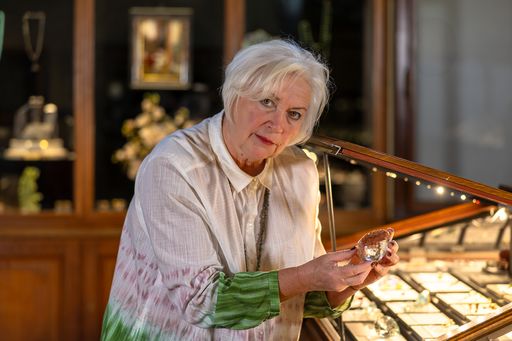BEHIND THE SCENES OF GEMSTONE COLLECTION
The NHM Vienna invites you to a press background discussion on Wednesday, November 20, 2024, at 10:30 a.m.
Gemological analysis in the laboratory: Gemstone identification in the Natural History Museum Vienna. Bring a piece of jewelry with you to the press event and our experts will tell you whether the stones are real…
With
HR Dr. Vera HammerHead of the Mineral and Gemstone Collection
Viola Winkler MScoperator micro-CT and 3D laboratory
Dr. Wencke Wegnermicroanalytics operator
“The gemstone collection in the Natural History Museum Vienna is one of the most historically important in Europe,” says Dr. Vera Hammer, head of the mineral and gemstone collection, who has been carrying out gemstone analyzes for decades. The display collection was reorganized in 2018, includes around 2,000 objects and is completely digitalized . There is also an extensive comparison collection for investigations.
In addition to minerals, precious and decorative stones have been collected for more than 420 years. While at the beginning it was only “oddities of nature” that attracted the attention of collectors, the material was increasingly collected systematically and scientifically.
The first objects were already there before the middle of the 18th century. This includes a large pendant with citrine. The note “ex thesauro caesareo” noted in the inventory proves that it was once stored in the imperial treasury in Vienna.
Some mirabilia (miracle things) from the famous Ambras Chamber of Art and Curiosities of Ferdinand II of Tyrol (1529-1595) come from a much earlier time. To protect against acts of war, the most valuable objects were brought to the capital Vienna, where they ultimately remained. These include two oriental rings made of milk quartz and lapis lazuli and some gemstones that demonstrate the collecting of precious stones going back to the Renaissance.
The actual foundation of the Vienna gemstone collection is the purchase of the collection of the naturalist Jean de Baillou (1684-1758) by Emperor Franz I. Stephen of Lorraine around 1750. It already contained 35 shops with precious and ring stones. “Unfortunately, only individual objects can be clearly traced back; these certainly included the diamonds that Cosimo III had already owned. de’ Medici (1642-1723) carried out experiments,” explains the NHM Vienna gemstone expert. He had tried to melt several small diamonds together into a large crystal. “The emperor’s repetition of this attempt using a large burning mirror in Vienna also failed. The diamonds transformed into graphite on the surface, which at least demonstrated the combustibility of diamond. The stones from this experiment have been preserved for us.” Some agate pendants also come from the Baillou collection.
In addition to minerals, rare gemstones from Brazil, such as euclase, chrysoberyl and colored diamonds, came to Vienna from the imperial family’s expeditions in the 19th century. The gemstone collection has been and continues to be continually expanded and expanded. Depending on the budget situation, the NHM Vienna still purchases objects and thus supplements the inventory. Valuable private collections came to the museum through donations in the 19th century, such as the ring collection of the civil servant Friedrich Hoppe and the gem collection of the industrialist Richard von Drasche-Wartinburg. Jacob F. van der Nüll’s famous collection also contained outstanding gemstones.
The largest addition in the 20th century was the estate collection of August C. von Loehr with almost 2,500 objects. Only a fraction of the existing stones can be displayed; Many of these gemstones are still valuable comparison material for teaching, scientific research and analysis today.
The NHM Vienna has been leading the identification of precious and decorative stones for more than 70 years, producing material analyzes and gemmological reports. The equipment with testing equipment for non-destructive determination has been continually improved. A micro-Raman device is available for polished stones and an X-ray diffractometer is available for determining gemstones. By using micro-computed tomography from the Department of Central Research Laboratories, the NHM Vienna is a leader in the analysis of pearls in Austria.
Material analyzes are carried out in the different departments of the NHM Vienna. for CITES reports, for example, because many of the animals or their parts that are now protected species were and are used in jewelry and art objects – think, for example, of ivory, coral or mussel or snail shells. The NHM Vienna is a reliable contact for official inquiries from customs or the police.
Written material reports are prepared for a fee; the proceeds from this benefit the museum for new purchases.
The academic education of students at various universities and colleges is maintained. Also worthy of mention is the international expert conference in 2018, which was held together with the main association of generally sworn and court-certified experts in Austria and the Central Association of German Gold and Silversmiths in the Natural History Museum.
The numerous lectures and tours behind the scenes also make a further contribution to adult education, where trainee goldsmiths also learn interesting facts about gemstone identification and get to know the responsible contact person if they have any questions.
The good, interdisciplinary collaboration with various universities, the Gemmological Laboratory Austria, the Austrian Gemmological Society, the various auction houses and the professional associations is what makes the NHM Vienna experts successful.
Meeting point: NHM Vienna, Lower Kuppelhalle, Maria-Theresien-Platz
RSVP (only if accepted): presse@nhm.at
Press materials for download:
https://nhm.at/presse/pressemitteilungen2024/edelsteinsammlung
Invitation: Behind the scenes of the gemstone collection
Datum: November 20, 2024, 10:30 a.m
Ort: NHM Vienna
Burgring 7
1010 Wien
Austria
URL: https://nhm.at/presse/pressemitteilungen2024/edelsteinsammlung
